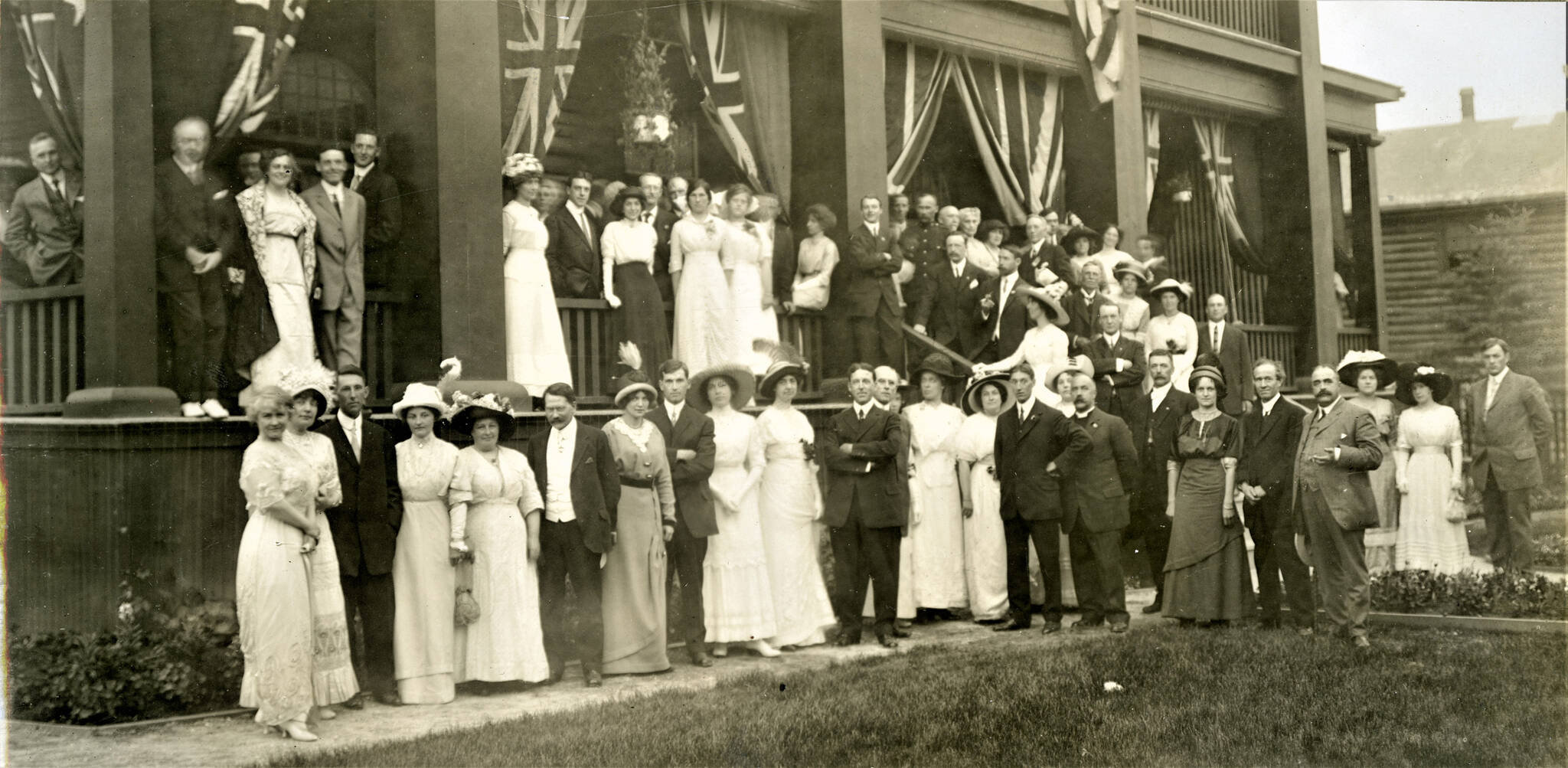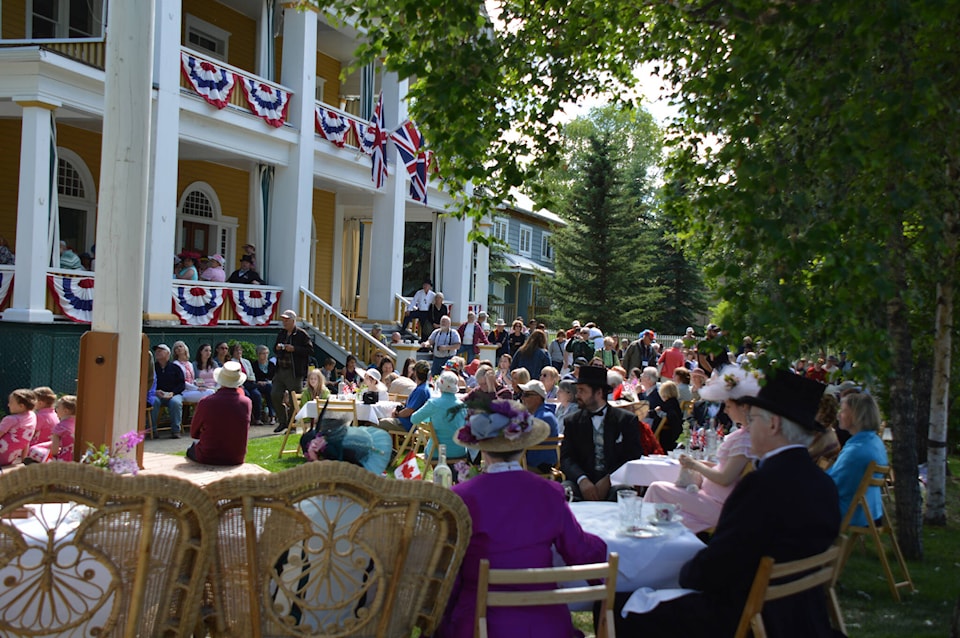The Commissioner’s Residence, located prominently on Front Street in Dawson City, was the home of the federal government’s leading official during their term in office and it served several different functions: personal, social and official. The building, as you see it today, represents the period when its most famous residents, Commissioner George Black, and his wife, Martha, lived here, from April of 1912 until October of 1916.
George was an amateur taxidermist, and Martha had a passion for flowers, both wild and domestic, and both of their imprints are to be found in the building today. Behind the residence stood a sizeable greenhouse, which was kept warm throughout the year by a large steam plant. The scope and diversity of flowers grown there during that period were impressive, and floral displays were a part of every social event. George was an avid hunter, and several trophies are mounted and displayed on the main floor of the building.
Picture this: it was April of 1912 and the newly appointed commissioner, and his wife, had just moved into Dawson’s most palatial home. They held an enormous reception to which the entire town seemed to have been invited. According to author Laura Berton, after the select gatherings of the previous regime, this was democracy in its broadest sense. The building was jammed from top to bottom with guests, all friends of the Blacks. There were miners in evening dress, miners in morning dress, miners in overalls and even miners in gum-boots.
It doesn’t make any difference whether you were dressed in overalls or a swallowtail. George Black said, “you come in and enjoy yourselves.” It didn’t make any difference to the commissioner or his wife.
When you entered through the flag draped portal, the strains of music could be heard from the orchestra, which was set up on the landing half way up the grand staircase. After leaving your over-garments in one of the rooms upstairs, you returned to the main floor and entered the reception room, where you were greeted by the Blacks and various prominent dignitaries that made up the higher echelons of Dawson society: the commanding officer of the Mounted Police, the chief justice, the Anglican bishop, and the American consul. From there, you mingled with the hundreds in attendance, taking a glass of punch and a sandwich in the dining room.

The men gathered in the study to talk and “burn the Havana incense,” or went to the third floor to play billiards, while the ladies gathered round the punch bowl or joined the card games on the second floor.
Later, the furniture was moved back and the carpets were rolled up, and the dancing continued until 2:00 in the morning. That was followed by more card games and conversation that continued until the last guests left in the early hours.
Other functions at the residence, which was known officially as “Government House,” were aimed at creating a positive experience for visiting investors. July 3, 1913, the Seattle Chamber of Commerce joined the gathered throng at a reception organized by the newly formed George Dawson chapter of the Imperial Order, Daughters of the Empire, or IODE.
Over the years, in addition to investors, many prominent guests, such as cabinet ministers, and even the governor of Alaska (who was secretly a Canadian), stayed at the residence, as well as members of the extended Black family.
Even the furnishings were chosen to reflect the image of modernity in this most remote region of the British Empire. The large hall stand in the front vestibule was intended to accommodate guests while domestics went to see if the lady of the house was available for visitors. They could check themselves over in the mirror inset in the stand, and hang their outer apparel on hooks mounted on either side of it.
Beside the hall stand stood a receptacle to hold the umbrellas that nobody in Dawson seemed to use, while upon the table on the opposite side of the vestibule was the silver card receiver, onto which visitors could leave their carefully coded calling cards. Heaven forbid one should not know the protocols of calling cards.
The dining room contained numerous hints of affluent elite culture, from the carefully arranged plates, glasses and silverware, to the stylish Arts and Crafts wallpaper, and the prominent sideboard. I learned many years ago when confronted with such displays, to wait until others started eating before choosing which utensils should be used, and in which order.
The dining room and the study seemed to be filled with things that suggested death and gore. Framed pictures of hunt scenes hung on the wall here, and in the study, to attest to the sport of hunting, as did mounted moose and caribou heads and game birds. These indicated that hunting was not just to provide food, but also to pass the leisure time available to upper class males. All these things were designed to assert status and provide social distance.
The building was shut down in the fall of 1916, and never occupied again until 1950, except for a brief stay by the Governor General, Lord Byng of Vimy, during his visit in 1922. When Lord Byng went off to visit the Mayo mining district, Lady Byng remained in the residence until her departure, attending social functions and receiving visitors.

According to the Dawson Daily News, one of these was Chief Isaac, leader of the Moosehide people. He came dressed in moose skin and caribou attire, elaborately beaded from head to foot, wearing a hat with feathers, and carrying a bow and arrow…
“Lady Byng and the chieftain conversed some little time, and the chief (in his customary fashion) took the opportunity to assert that he and his fathers had ruled this realm for many generations and owned the hundreds of millions in gold which made the Klondike famous, …”
Before leaving, Chief Isaac presented Her Excellency with a diminutive parka, a hooded gown of the traditional kind the First Nation mushers used on the trails before Europeans came, and other gifts from Moosehide residents – a First Nations doll, beaded moccasins and beaded tobacco pouch. Sam Smith’s wife sent a large moose skin cushion cover and a pair of white caribou slippers trimmed in fur.
After all of the parties, all the social functions, the IODE meetings and other special events, this was the first time I could find any evidence that any First Nation person ever attended. For although the Yukon claimed to be an egalitarian society, there was one segment of the community that was excluded from the social life of Dawson.
For almost a century, the First Nation people remained virtually invisible in Yukon society. Land claims have changed all that, and First Nations now play a prominent part in territorial affairs. All the old rules and conventions are mere memories. Today, this impressive structure is a reminder of British colonialism on the traditional territory of the Tr’ondëk Hwëch’in.
Michael Gates is Yukon’s first Story Laureate. His new book, “Hollywood in the Klondike,” is now available in some stores. You can contact him at msgates@northwestel.net
